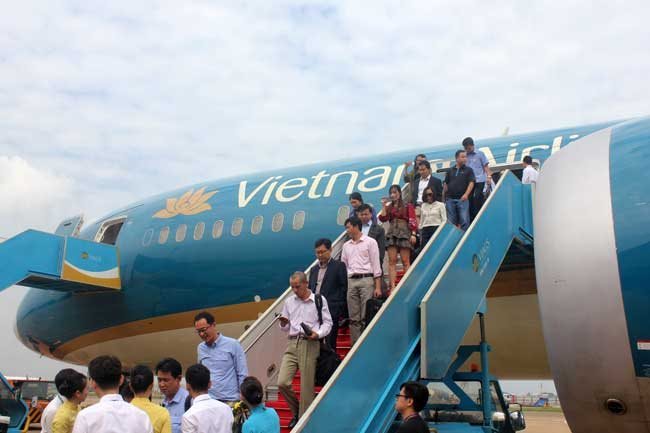 |
| Passengers disembark from a Vietnam Airlines aircraft |
In the first year of operations, Vietravel Airlines will use three Airbus 320/321 or B737 aircraft. The number of aircraft in its fleet is expected to increase to eight in the next five years.
On February 19, Vietravel Airlines received its business license from the Department of Planning and Investment of the central province of Thua Thien-Hue, where Vietravel Airlines will be headquartered. It also increased its charter capital from VND300 billion to VND700 billion in May.
The Thua Thien-Hue Department of Planning and Investment has consulted the Ministries of Planning and Investment and Transport on the appraisal of the Vietravel Airlines air passenger transport project.
The project, which requires an investment of VND700 billion, is aimed at providing air transport services at home and to other countries, contributing to the development of Vietnam’s aviation and tourism sectors.
In related news, Vietnam Airlines has reported its business performance in the first half of the year, with consolidated revenue reaching VND51.7 trillion, up 5.5% year-on-year, and consolidated pretax profit exceeding the target by 30% to hit VND1.65 trillion.
In the period, the airline continued to have positive financial indicators, with a debt to equity ratio of 2.32, lower than the 2.58 seen early this year and well below the limit set by the State.
The national flag carrier operated 73,650 safe flights, carrying over 13.9 million passengers and 180,000 tons of cargo, up 2% and 1.6% year-on-year, respectively. Its on-time performance, averaging at 90%, remained among the highest globally.
Thanks to its operational efficiency, Vietnam Airlines Group (including Vietnam Airlines, Jetstar Pacific and Vietnam Air Services Company) continued to spearhead the local aviation market, carrying nearly 51% of the aggregate passenger volume.
These figures reflect Vietnam Airlines’ robust performance amid a slowdown in purchasing power growth, a surge in fuel prices during the first five months and fluctuations in the exchange rates.
In the January-June period, Vietnam Airlines also introduced Premium Economy Class on the Hanoi-HCMC route. In addition, the quality of its services on international flights was further improved as the carrier began using wide-body Airbus A350 and Boeing 787 aircraft on routes to other Southeast Asian destinations and moved its operations in Russia’s capital of Moscow from Domodedovo Airport to Sheremetyevo Airport.
Further, Vietnam Airlines Group launched seven new domestic routes connecting HCMC to Chu Lai, Hanoi to Dong Hoi and Danang to Thanh Hoa, Vinh, Dalat, Phu Quoc and Can Tho.
In the first six months, the carrier received eight narrow-body Airbus A321neos and two wide-body Airbus A350s, completing its total order of 14 Airbus A350s.
In the second half of 2019, Vietnam Airlines plans to invest in 20 narrow-body Airbus A321neo aircraft and put into use three wide-body Boeing 787-10s. SGT
Le Anh

PM orders reports on airlines staff shortage
Prime Minister Nguyen Xuan Phuc has asked the Ministry of Transport to report on the shortage of airlines staff and solutions affecting Vietnamese airlines.

Private airlines bring dynamism to Vietnam’s aviation industry
The foray of private airlines have brought dynamism to Vietnam’s aviation industry, according to Vu Tien Loc, president of Vietnam Chamber of Commerce and Industry (VCCI).
 Vietravel Airlines, an airline just established by local tour operator Vietravel, plans to launch its maiden flight in October next year.
Vietravel Airlines, an airline just established by local tour operator Vietravel, plans to launch its maiden flight in October next year.